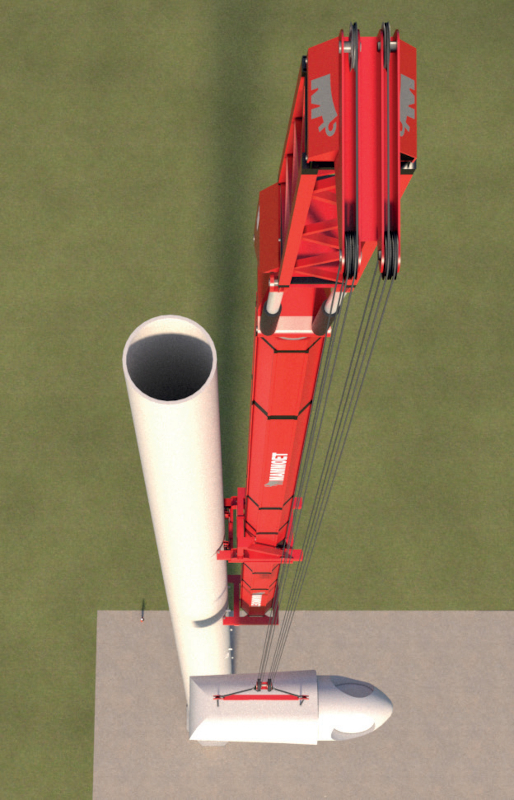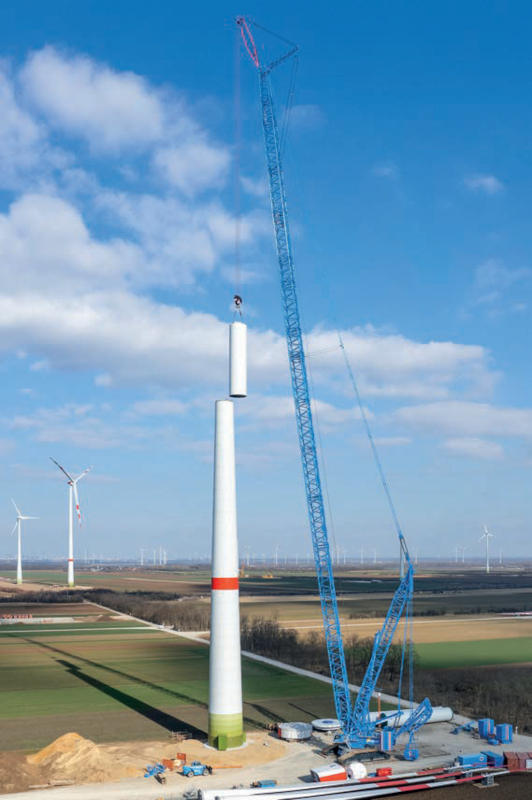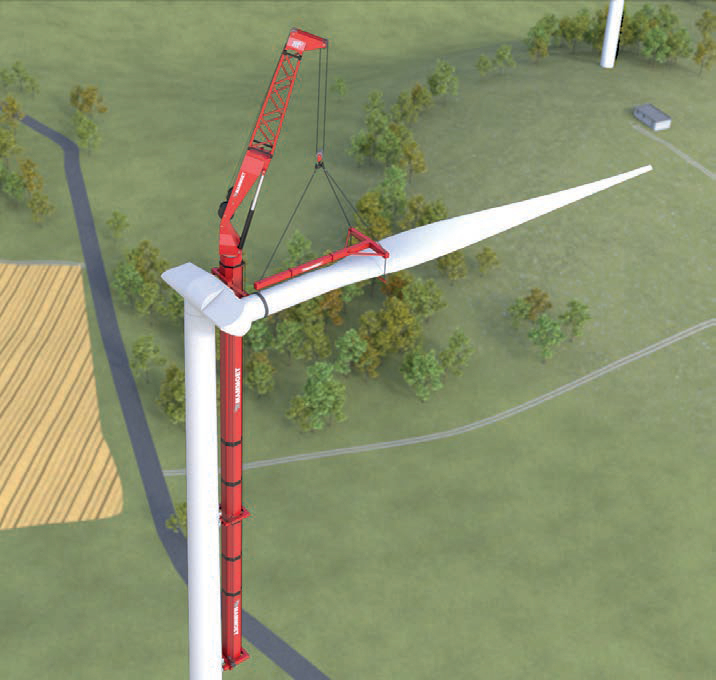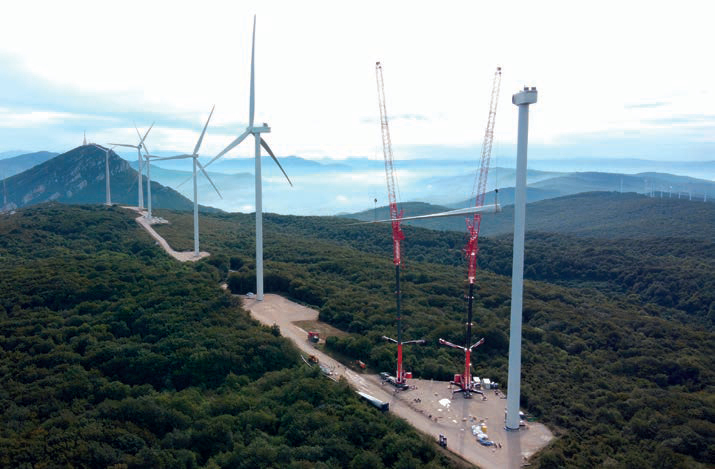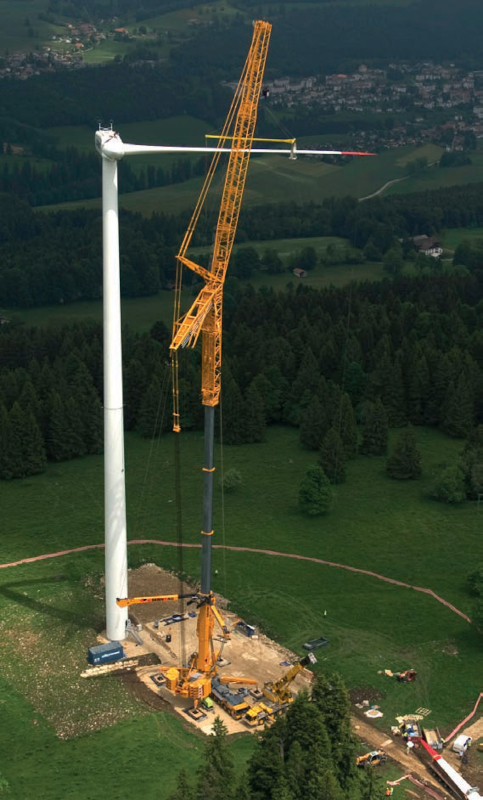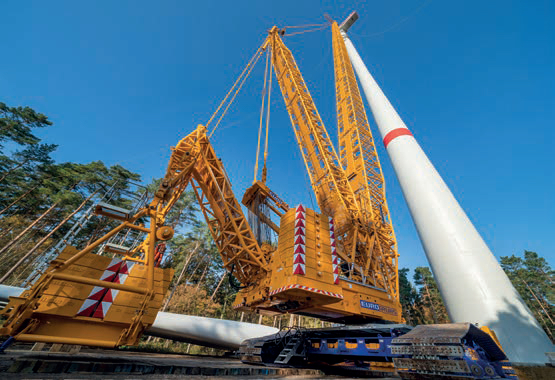Different strokes
22 July 2022Building onshore wind farms demands high lifts in limited spaces at remote locations in strong winds. Julian Champkin looks at the challenges and various approaches.
In 2011 all the onshore wind turbines in the world could generate 216 GW between them. Ten years later, in 2021, onshore wind capacity was 769 GW, almost four times greater. (Source: IEA, International Energy Authority, tracking report, Nov 2021.) And it is going to grow much, much faster than that.
In 2020, global capacity additions increased by an unprecedented 108 GW, double the growth of 2019. A commissioning rush in China and the United States together accounted for 79% of global wind deployment.
Last year €41bn was invested for the construction of new onshore wind farms in Europe, financing a record 24.6 GW of new capacity. Wind power today generates around 15% of Europe’s energy.
Turbines have increased not only in numbers but also in size. In 1985, typical onshore turbines had a rated capacity of 0.05 MW and a rotor diameter of 15 metres. Today’s new projects have turbine capacities of about 2 MW onshore – and an even greater 3–5 MW offshore. To attain the 8,000 TWh required in 2030 under the Net Zero Emissions by 2050 climate change scenario, generation must increase by an average 18% each year from now until 2030. It will be necessary to add 310 GW of capacity in onshore wind each year (Source: IRENA, International Renewable Energy Agency.)
So onshore wind is booming. It has, so to speak, the wind behind it. Farms will be built, and are being built, at an ever-increasing rate.
Yet, strangely, there seems little agreement on the best type of crane to use to build them. A standardised method has yet to evolve. Tower cranes, all-terrains, lattice crawlers... all kinds of different cranes have been taken to sites and gainfully employed there to build the ever-taller towers and install the ever-longer blades; and no consensus has emerged on which is or will be the most efficient and the most economical.
This may be partly due to the requirements of wind farm lifting. The combination of desirable qualities is unique and sometimes conflicting. Height is an obvious requirement of your crane. The earliest towers stood at 60 metres; they rapidly grew to double that and today 160 and 165 metre towers are common in Europe, and some reach even higher, to 180 metres. Footprints may also be restricted: mountaintops do not usually offer much spare space. Great lifting heights and small footprints are characteristic of high-rise construction sites in cities, and there the tower crane is all but universal. Why not in wind farms?
Tower cranes have certainly been used and continue to be used. Danish makers Krøll have their specialised K760L luffing tower cranes for wind turbines, and have used them to install, for example, more than 70 units in different locations in Thailand.
But access is another constrain, and it can militate against tower cranes. Wind farms tend, for obvious reasons, to be built on high, remote places with approach roads, if they exist at all, being steep, narrow, unpaved and frequently hairpin. Getting your tower crane up there may be more than problematical.
And, once there, laydown space is yet another limitation. On steep and rocky mountaintops spare ground for assembling your crane may be in very short supply – and spare ground that is sloping at anything less than 45 degrees even more so.
And – yet one more constraint – on a site with multiple turbines, moving your crane from one to another in the limited space between them is another problem for tower cranes.
From that last point of view, lattice boom mobile cranes therefore become an attractive option – and in so far as there is a standard solution, they are it. “Lattice boom cranes such as the Liebherr LG 1750 have been the standard solution for the installation of the latest generation of turbines, with a tower height up to 140m or more,” says Carlos Moreno, global segment leader for onshore wind at Mammoet. The LG 1750 lattice boom mobile crane has the turntable and boom system from Liebherr’s LR 1750 crawler crane mounted on an eight-axle mobile-crane tyred chassis with speed-dependent rear-axle steering, so it combines the flexibility of a 750 tonne crawler crane with the mobility of a mobile crane.
Jens Könneker is Liebherr’s product manager for crawler cranes and is also their onshore wind specialist. “I think in the early days everyone used smaller cranes or telescopic boom cranes,” he says. “Our LTM 1500 all-terrain became a benchmark for the telescopic boom crane erection of wind turbines; then as towers became bigger and bigger the LTM 1750 and LTM 11200 took over.” (The latter is Liebherr’s largest all-terrain crane, with 1,200t capacity.) Then lattice boom crawlers came into it: we started with the LR1500, then we launched our LR 1600 which I think was the first standard wind farm machine we had for the European market. Both of those had booms long enough to cope with the height of the towers at that time, which were 120m to the hub. Towers grew, to 130m, then to 135m which, for a long period, was standard tower height – or more accurately hub height, since that is what matters; it got extended to 140m around 2008. The next step, to 150 m, came very quickly after that.
“In 2015 the turbine manufacturers began talking about 165 metre hub heights, which was a big step up, and for that we developed our ‘SX’ systems of boom extensions for our lattice cranes. Now, in 2022, 165 m has become the standard hub height and an operator wanting to put up a new wind farm could well choose an LR 1750 with two or three boom extensions depending on the load he has to lift.”
All of this sounds simple; but we are talking an awful lot of steel and lifting power here. “These are big machines,” says Könneker. They are actually very big machines indeed. “Three years ago I was at the Hamburg wind fair when an operator complained to me: ‘Your cranes keep on getting bigger and bigger needing more and more space on the ground.’ l could only reply: ‘Your towers are getting taller and taller; you think you are going to need smaller cranes to erect them?’
“We always imagine that we are at the limit of what is practically achievable, and then someone comes round the corner with something bigger or taller that needs to be set in place.
“I think we are at that stage now. Manufacturers want taller towers with longer blades, for efficiency and higher output. An immediate increase of 35 metres, to 200m hub height, would be a step too far, too much to manage in one jump; there will be an intermediate stage, to around 180m, and we will be able to manage those heights with the LR1100 and LR1800 lattice crawlers. We are preparing those so that they can operate at that height for the next generation of towers.”
Even when they have selected a big lattice crawler, though, wind farm contractors have options. “There are two different, maybe contradictory, demands in wind farm lifting,” says Könneker. “The heaviest load is the nacelle, at 100t or 110t weight. For that you need capacity from your crane. But then you lift the blades, which are only half that weight; but you must lift them to a greater height, to 50m or 80m above the nacelle. The sensible thing would be to change booms between those operations: lay down the shorter, high-capacity boom and swap it for a longer, low-capacity one. But that takes time, about half a day. Operators want a single boom and crane that will do both operations. That is certainly possible, it just needs a crane that is a size bigger – and so a size more expensive. It is up to the operator to do his sums, to decide whether he want to pay the extra money to save half a day in time. Most of them tend to prefer to pay the money and save the time.
“That is the European market; mountain top sites require laydown space, roads to ship in the cranes, and so on, which takes planning. In the US they have it easier. They tend to build their wind farms in deserts, where there are no trees to get in the way, where the ground is flat and you can move your crawler cranes around while they are carrying the load. So they can erect their wind farms more quickly, very quickly in fact; but it helps that their towers and hub heights are shorter than in Europe: they are 100m, 105m, sometimes 110m at the hub. You expect things in America to be bigger, but in wind farms they are not.”
Even in Europe, the lattice booms do not have it all their own way. “Tower cranes are an option for wind farms, and they are used: our colleagues at Liebherr’s Biberach works produced the EC-B 125 with exactly that application in mind. But around ten years ago the turbine manufacturers said: ‘You cannot use our tower foundations to support your cranes; and you cannot tie on to our towers to stabilise your cranes.’ That made it a little hard for our tower-crane colleagues. But today, with taller towers, the turbine-makers’ mindset has changed. The cost, and the limited availability of the big crawlers, has persuaded them that tower cranes are a sensible solution after all. So now they allow their foundations to be used for a tower crane, and also they allow tie-ons. That is why companies like Krøll in Denmark are again designing tower cranes for that purpose.”
“But when hub heights reach 200 metres we may have to think of new solutions,” he says. “The need then may be for a different kind of lifting. It may be that the future shall switch to different solutions entirely, to some more exotic design. So Mammoet for example have their tower-climbing crane; we will see how it will do.”
Mammoet’s Carlos Moreno, whom we quoted earlier, explains the concept of the WTC, their Wind-Tower Climbing crane: “More and more we see the tendency for wind turbines to get heavier and higher. There is huge pressure to reduce the cost of energy and that is pushing OEMs to make turbines bigger and more effective and with a better power output.
“Onshore wind lifting is quite particular. You need high capacity lifts at a short working radius; and minimising the civil works on the ground is important as well. You need to be able to place your crane as close as possible to the turbine tower to reduce the ground-strengthening you have to do; that means that you need a particular type of boom configuration, with short jibs and high lift at the tip. So conventional cranes are not particularly planned for wind turbines.
“And obviously in wind farms, heavy cranes impose big ground loads so road and ground conditions are always a challenge. We need to relocate around the site quickly and efficiently.
“So you get a contradiction: The bigger the crane, the more civil ground-works you are going to need. And the higher you go, the longer the boom and the bigger the working radius, so you need to place your crane further from the wind turbine tower and have more lay-down space for the boom. And for that you need more ground-works again; so you are stuck in a vicious circle. We need to think of something completely different that will break out of it.”
The tower-climbing crane is exactly that. “It climbs up the tower itself, so it could hardly be closer to the tower. That means the boom can be very short. Therefore you don’t need boom-down corridors on the ground. In terms of height, we can climb as high up the tower as we like, so we can look at 200m or 220m; we are effectively limitless. We can just keep on climbing. When we designed the WTC we did a thorough analysis of weights and dimensions of turbine components from different manufacturers both now and in the future, so we are confident that it can assemble today’s and tomorrow's turbines.”
With so much less steelwork it is light, meaning that civil works are greatly reduced, and it is easy to transport. “It is made up of only nine different pieces, so that is nine truckloads to bring it to the site. Compare that to a conventional crane that can need 80 or even 90 loads to transport it. It is a significant difference. So it is simpler. It can be transported to sites in a more cost-efficient way.
“And on site you assemble the WTC and it builds the first turbine, but during the relocation process you don't need to dismantle it completely again. You can leave some of the components assembled and transport them together, in just five truckloads. So that does make it very, very cheap.” And – another advantage – it can work in winds up to 15-20 metres a second, which is beyond the safe limit for most lattice cranes.
It will come in two versions, one for erection of turbines and a second one for maintenance. Since it will not have to carry such heavy loads the maintenance version can be smaller and lighter. “We are hoping to bring them to market in 2023. I really do see this it as the future for installing heavier and higher wind turbines. ”
Unless, of course, something even more out-of-the-box appears that can also economically lift 100 tonnes or more 200 metres into the air on a close-to-zero footprint at a remote mountaintop site that has almost-perpetual high winds and pine trees all the way round that are getting in your way. If you can think of such a device I am sure that wind farm owners would be interested.
Watch the Cranes Today video interview with Mammoet's Carlos Moreno at: www.cranestodaymagazine.com
